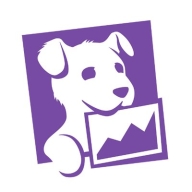

Datadog and LogRhythm SIEM compete in the fields of performance monitoring and security management. Datadog holds an advantage with its ease of integration and user-friendly cloud setup, while LogRhythm SIEM excels in enterprise-level compliance and threat intelligence.
Features: Datadog offers a cloud-hosted setup with no infrastructure needs, focusing on extensive integrations, customizable dashboards, and comprehensive visualization tools. LogRhythm SIEM is valued for its log aggregation, AI-driven threat intelligence, and compliance features aimed at regulatory needs, particularly for large enterprises.
Room for Improvement: Users of Datadog note the need for better metrics collection and display options, cost transparency, and third-party integration. LogRhythm SIEM users suggest improvements in scalability, reporting capabilities, interface intuitiveness, and automation.
Ease of Deployment and Customer Service: Datadog supports diverse environments such as public clouds and hybrid setups, targeting businesses focused on scalability. LogRhythm SIEM is preferred for on-premises implementations for internal data handling. Both products receive positive feedback for customer service, with Datadog noted for responsiveness and LogRhythm for its proactive support team.
Pricing and ROI: Datadog's pricing is use-based, which can lead to higher costs with increased consumption. It offers flexibility with pricing models based on host usage and custom metrics. LogRhythm SIEM offers a straightforward licensing model and is considered premium, providing substantial value for log management and compliance features, often more competitive than peers such as IBM QRadar.
Previously we had thirteen contractors doing the monitoring for us, which is now reduced to only five.
Datadog has delivered more than its value through reduced downtime, faster recovery, and infrastructure optimization.
I believe features that would provide a lot of time savings, just enabling you to really narrow down and filter the type of frustration or user interaction that you're looking for.
When I have additional questions, the ticket is updated with actual recommendations or suggestions pointing me in the correct direction.
Overall, the entire Datadog comprehensive experience of support, onboarding, getting everything in there, and having a good line of feedback has been exceptional.
I've had a couple instances where I reached out to Datadog's support team, and they have been really super helpful and very kind, even reaching back out after resolving my issues to check if everything's going well.
The technical support is good; we have a separate portal for partners, and since we are paying for the service, they provide a response timeframe based on severity—critical issues are addressed within four hours, medium issues within one day, and non-urgent issues may take a couple of days.
Customer support is very helpful and effectively solves my problems.
Datadog's scalability has been great as it has been able to grow with our needs.
We did, as a trial, engage the AWS integration, and immediately it found all of our AWS resources and presented them to us.
Datadog's scalability is strong; we've continued to significantly grow our software, and there are processes in place to ensure that as new servers, realms, and environments are introduced, we're able to include them all in Datadog without noticing any performance issues.
LogRhythm SIEM is highly scalable as it has modular components allowing me to expand storage, indexing, or other resources as needed.
LogRhythm SIEM is scalable; it can handle about 200 or 500 devices without much difference.
The scalability of LogRhythm SIEM is good enough, warranting an eight out of ten rating.
Datadog is very stable, as there hasn't been any downtime or issues since I've been here, and it's always on time.
Datadog seems stable in my experience without any downtime or reliability issues.
These incidents are related to log service, indexes, and metric capturing issues.
The platform needs regular updates to fix problems encountered with each quarterly patch and version release.
LogRhythm SIEM still needs improvement regarding stability, particularly in environments with heavy data consumption.
It would be great to see stronger AI-driven anomaly detection and predictive analytics to help identify potential issues before they impact performance.
The documentation is adequate, but team members coming into a project could benefit from more guided, interactive tutorials, ideally leveraging real-world data.
In future updates, I would like to see AI features included in Datadog for monitoring AI spend and usage to make the product more versatile and appealing for the customer.
I have noticed some problems with parsing errors, event mismatches, and data mismatching, so ensuring accurate parsing and continuous improvement according to device updates are my basic expectations as a detection engineer.
There is currently no way to determine how much data is being consumed in terms of gigabytes, terabytes, or petabytes from particular devices or environments.
A more user-friendly user interface with drag-and-drop features, similar to key competitors like Splunk, would be beneficial.
The setup cost for Datadog is more than $100.
Everybody wants the agent installed, but we only have so many dollars to spread across, so it's been difficult for me to prioritize who will benefit from Datadog at this time.
My experience with pricing, setup cost, and licensing is that it is really expensive.
The license cost is around $10 per MPS.
I find LogRhythm SIEM affordable, as it is a bit less costly than QRadar.
Our architecture is written in several languages, and one area where Datadog particularly shines is in providing first-class support for a multitude of programming languages.
Having all that associated analytics helps me in troubleshooting by not having to bounce around to other tools, which saves me a lot of time.
Datadog was able to find the alerts and trigger to notify our team in a very prompt manner before it got worse, allowing us to promptly adjust and remediate the situation in time.
The seamless integration for case management, along with a user-friendly dashboard user interface, makes tasks like threat hunting more efficient.
We have enough budget for cloud deployment, but we choose to keep it on-prem to ensure data privacy; cyberattacks are a concern, but data privacy is the foremost priority due to sensitive government information.
This helps SOC analysts significantly as they can monitor all log sources through a dashboard, quickly identifying which sources haven't reported within their specified timeframes.
| Product | Market Share (%) |
|---|---|
| Datadog | 5.4% |
| LogRhythm SIEM | 2.2% |
| Other | 92.4% |


| Company Size | Count |
|---|---|
| Small Business | 80 |
| Midsize Enterprise | 46 |
| Large Enterprise | 95 |
| Company Size | Count |
|---|---|
| Small Business | 38 |
| Midsize Enterprise | 38 |
| Large Enterprise | 83 |
Datadog integrates extensive monitoring solutions with features like customizable dashboards and real-time alerting, supporting efficient system management. Its seamless integration capabilities with tools like AWS and Slack make it a critical part of cloud infrastructure monitoring.
Datadog offers centralized logging and monitoring, making troubleshooting fast and efficient. It facilitates performance tracking in cloud environments such as AWS and Azure, utilizing tools like EC2 and APM for service management. Custom metrics and alerts improve the ability to respond to issues swiftly, while real-time tools enhance system responsiveness. However, users express the need for improved query performance, a more intuitive UI, and increased integration capabilities. Concerns about the pricing model's complexity have led to calls for greater transparency and control, and additional advanced customization options are sought. Datadog's implementation requires attention to these aspects, with enhanced documentation and onboarding recommended to reduce the learning curve.
What are Datadog's Key Features?In industries like finance and technology, Datadog is implemented for its monitoring capabilities across cloud architectures. Its ability to aggregate logs and provide a unified view enhances reliability in environments demanding high performance. By leveraging real-time insights and integration with platforms like AWS and Azure, organizations in these sectors efficiently manage their cloud infrastructures, ensuring optimal performance and proactive issue resolution.
LogRhythm SIEM Platform is an award-winning platform in security analytics. With more than 4,000 customers globally, LogRhythm SIEM is an integrated platform that helps security operations teams protect critical infrastructure and information from emerging cyberthreats. Ultimately, LogRhythm SIEM is an integrated set of modules that contribute to the security team’s fundamental mission: rapid threat monitoring, threat detection, threat investigation, and threat neutralization. LogRhythm SIEM is for organizations that require an on-premises solution and offers:
● Streamlined workflow
● Secure data access
● Real-time visibility
● A unified user experience
● Management customization
Security information and event management (SIEM) solutions have been evolving for over a decade; their core functionality still acts as the most effective foundation for any organization’s technology stack. A SIEM solution enables an organization to centrally collect data across its entire network environment to gain real-time visibility into activity that may pose a risk to the organization. SIEM technology addresses threats before they become significant financial risks while simultaneously helping better manage an organization’s assets.
LogRhythm SIEM has many key features and capabilities, including:
● High-Performance Log Management: LogRhythm SIEM offers structured and unstructured search capabilities which allows users to swiftly search across an organization’s vast data to easily find answers, identify IT and security issues, and troubleshoot issues. Users can efficiently process and index terabytes of log data daily.
● Network and Endpoint Monitoring: Forensic sensors allow users to gain deep visibility into endpoint and network activity. Users can see behavioral anomalies and better respond to incidents.
● SmartResponse™ Automation: LogRhythm SIEM allows users to centrally execute pre-staged actions that automate incident investigatory tasks and responses.
● Automated Machine Analytics: LogRhythm SIEM's AI Engine continuously analyzes all collected security incidents and forensic data. Security teams are delivered precise, real-time intelligence about risk-prioritized threats.
● Case and Security Incident Management: LogRhythm SIEM offers an integrated workflow so that threats don’t slip through the cracks. Collaboration tools help centrally manage and track investigations.
● User and entity behavior analytics (UEBA): Embedded deterministic UEBA monitoring helps protect against insider threats.
● Security orchestration, automation, and response (SOAR): LogRhythm SIEM includes our embedded SOAR solution to increase efficiency and higher-quality incident response with low mean time to response (MTTR).
Benefits to Using LogRhythm SIEM
● The platform offers great value to security and IT operations. Users have the ability to map their security and IT operations to existing frameworks such as NIST and MITRE ATT&CK.
● The platform offers broad integration across security and IT vendors: Users benefit from support for integration with hundreds of security and IT solutions. In turn, this further extends SIEM capabilities and data collection.
● The platform provides compliance adherence, enforcement, and reporting: The prebuilt compliance modules automatically detect violations as they occur and remove the burden of manually reviewing audit logs.
Reviews from Real Users
LogRhythm SIEM stands out among its competitors for a number of reasons. Two major ones are its ability to be customized and its quick performance of queries.
Jason G., a senior cybersecurity engineer, writes, "I have found the Advanced Intelligence Engine has provided the most value to us because we can customize alarms based on our requirements and have created hundreds of alarms that notify different people for different scenarios."
Andy W., principal consultant at ITSEC Asia, notes, “LogRhythm SIEM covers all our primary security analysis needs. It makes it easier for us to analyze threats and improves our response times. It's a versatile platform that performs queries fast compared to other SIEM solutions.”
We monitor all Log Management reviews to prevent fraudulent reviews and keep review quality high. We do not post reviews by company employees or direct competitors. We validate each review for authenticity via cross-reference with LinkedIn, and personal follow-up with the reviewer when necessary.